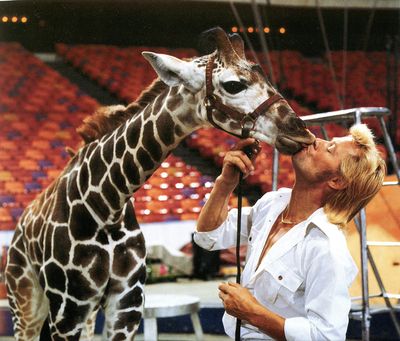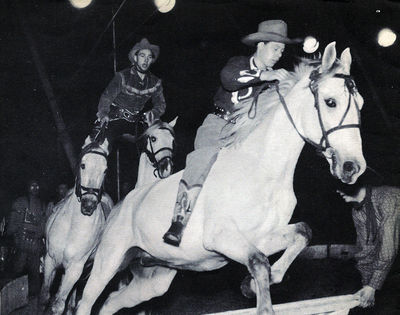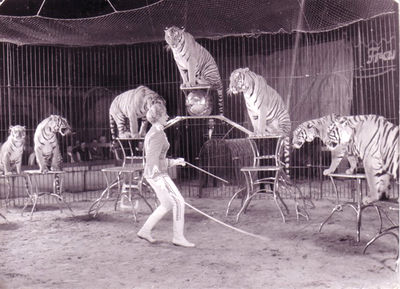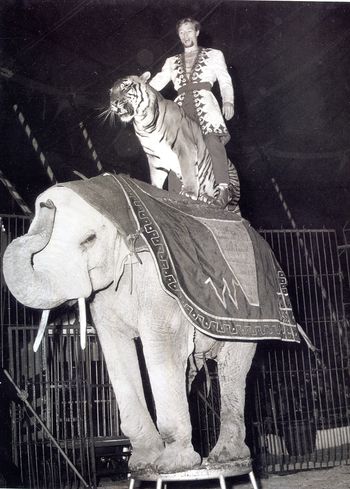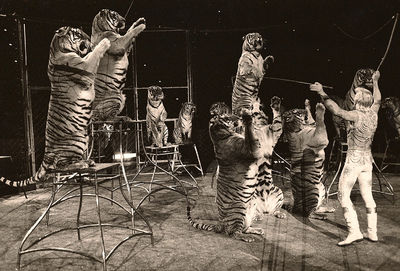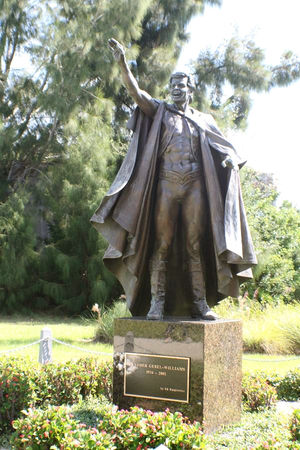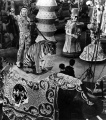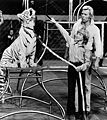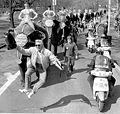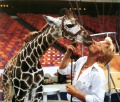Difference between revisions of "Gunther Gebel-Williams"
From Circopedia
(→Harry and Carola Williams) |
|||
| (9 intermediate revisions by the same user not shown) | |||
| Line 1: | Line 1: | ||
| − | [[Image:Gunther_Gebel-Williams_and_giraffe.jpg||right| | + | [[Image:Gunther_Gebel-Williams_and_giraffe.jpg||right|400px]] |
==Animal Trainer== | ==Animal Trainer== | ||
| Line 17: | Line 17: | ||
=== Harry and Carola Williams === | === Harry and Carola Williams === | ||
| − | Circus Williams had been created right after the end of the war, in 1946, by the German-born British equestrian [[Harry Williams]] (1902-1951), and his wife, [[Carola Williams|Carola]], née [[The Althoff Dynasty|Althoff]] (1903-1987). Harry Williams held a British passport, and the Althoffs—Carola and her brothers, [[Franz Althoff|Franz]] (1908-1987) and [[Adolf Althoff|Adolf]] (1913-1998)—had shown an exemplary attitude during the war (from the Allies' perspective), hiding notably many Jews | + | Circus Williams had been created right after the end of the war, in 1946, by the German-born British equestrian [[Harry Williams]] (1902-1951), and his wife, [[Carola Williams|Carola]], née [[The Althoff Dynasty|Althoff]] (1903-1987). Harry Williams held a British passport, and the Althoffs—Carola and her brothers, [[Franz Althoff|Franz]] (1908-1987) and [[Adolf Althoff|Adolf]] (1913-1998)—had shown an exemplary attitude during the war (from the Allies' perspective), hiding notably many Jews, performers or not, within their family’s traveling circus; the post-war Occupation authorities had had no problem delivering Harry and Carola Williams a permit to operate a circus again. |
| − | [[Image:Gunther_Gebel_-_Holdy_Barley_(1952).jpg|right|thumb|400px|Gunther Gebel at Circus Williams, 1952]]Yet, circus life didn’t suit Elfriede Gebel, and after a few weeks, she decided to call it quits | + | [[Image:Gunther_Gebel_-_Holdy_Barley_(1952).jpg|right|thumb|400px|Gunther Gebel at Circus Williams, 1952]]Yet, circus life didn’t suit Elfriede Gebel, and after a few weeks, she decided to call it quits, but left Gunther in the care of the Williamses as an apprentice with a five-year contract. Whatever young Gunther might have felt at first—so far, his family life had been no bliss anyway—he soon found in Harry and Carola Williams caring surrogate parents, and he would become in time a true member of their family, which already included son Alfons and daughter [[Jeanette Williams|Jeanette]], and [[Holdy Barley]], Carola’s son from a first marriage with [[Circus Barley|Harry Barley]]. |
Circus Williams was to become one of Germany’s preeminent circuses; in the immediate post-war period—a golden era for European circuses—it boosted a collection of eighty horses and its well-stocked menagerie included a group of five elephants. Harry Williams was an excellent and respected all-around equestrian; he had been a good acrobat on horseback, and was a fine liberty trainer and high school rider. One of his specialties was a spectacular Roman chariot race that he performed at breakneck speed at the end of the show. The first thing Gunther learned with his tutor was how to take care of the horses. | Circus Williams was to become one of Germany’s preeminent circuses; in the immediate post-war period—a golden era for European circuses—it boosted a collection of eighty horses and its well-stocked menagerie included a group of five elephants. Harry Williams was an excellent and respected all-around equestrian; he had been a good acrobat on horseback, and was a fine liberty trainer and high school rider. One of his specialties was a spectacular Roman chariot race that he performed at breakneck speed at the end of the show. The first thing Gunther learned with his tutor was how to take care of the horses. | ||
| Line 37: | Line 37: | ||
In 1955, Circus Williams hired a young Dutch cat trainer, [[Tini Berman]], known to the business as "Miss Yvonne," who presented a group of lions from [[The Knie Dynasty|Circus Knie]] trained by Ladislav Ira. Gunther fell head over heels for her, and his interest for big cats grew exponentially. To his delight, he was eventually asked to replace her in the big cage for one performance: This was his first experience working with cats in the ring, and he liked it. Yet the experience didn’t do anything to bring him closer to his paramour: Tini was happily married. | In 1955, Circus Williams hired a young Dutch cat trainer, [[Tini Berman]], known to the business as "Miss Yvonne," who presented a group of lions from [[The Knie Dynasty|Circus Knie]] trained by Ladislav Ira. Gunther fell head over heels for her, and his interest for big cats grew exponentially. To his delight, he was eventually asked to replace her in the big cage for one performance: This was his first experience working with cats in the ring, and he liked it. Yet the experience didn’t do anything to bring him closer to his paramour: Tini was happily married. | ||
| − | By the time Adolf Althoff left Circus Williams in 1956, Gunther had practically completed his circus education. At twenty-two, he now helped his surrogate mother, Carola, in the day-to-day management of the circus. He would continue to learn animal training by watching Circus Williams’s very capable trainers, notably its Master Equestrian, [[Fred Petoletti]] (the son | + | By the time Adolf Althoff left Circus Williams in 1956, Gunther had practically completed his circus education. At twenty-two, he now helped his surrogate mother, Carola, in the day-to-day management of the circus. He would continue to learn animal training by watching Circus Williams’s very capable trainers, notably its Master Equestrian, [[Fred Petoletti]] (the son of the legendary [[Circus Sarrasani]]'s illustrious Master Equestrian), who had trained the pride of Circus Williams's stables, its beautiful group of twenty-four Lipizzaner horses, which he presented together in one ring in a superb liberty display—an act that Gunther and Jeanette would later take over. |
But cats now fascinated Gunther, and working with them was his next goal. He eventually conceived an act with a young tiger he trusted, ''Bengali'', paired with a young African elephant, ''Kongo''. The act, which quickly became a sensation, made its debut at the [[Circus Williams|Spanischer National Circus]]—a title Circus Williams adopted for a joint venture with Spanish impresarios [[Manuel Feijóo]] and [[Arturo Castilla]] from 1962 to 1966. Gunther’s tiger and elephant act would later include a second elephant, and then two more tigers. | But cats now fascinated Gunther, and working with them was his next goal. He eventually conceived an act with a young tiger he trusted, ''Bengali'', paired with a young African elephant, ''Kongo''. The act, which quickly became a sensation, made its debut at the [[Circus Williams|Spanischer National Circus]]—a title Circus Williams adopted for a joint venture with Spanish impresarios [[Manuel Feijóo]] and [[Arturo Castilla]] from 1962 to 1966. Gunther’s tiger and elephant act would later include a second elephant, and then two more tigers. | ||
| Line 43: | Line 43: | ||
=== Enter Gunther Gebel-Williams === | === Enter Gunther Gebel-Williams === | ||
| − | [[Image:Gunther_Gebel_with_Bengali_and_Kongo.jpg|thumb|right|350px|Gunther, Bengali, and Kongo]]By then, Carola’s children had graduated from school, Alfons with a diploma in hotel and restaurant management, and Jeanette with a commerce diploma. Nonetheless, they both returned to the circus; Jeanette became an elegant high school rider, and Alfons specialized in the presentation of liberty acts. But tragedy struck again, when Alfons was killed in a car accident in 1960. For a long time now, Carola Williams had considered Gunther | + | [[Image:Gunther_Gebel_with_Bengali_and_Kongo.jpg|thumb|right|350px|Gunther, Bengali, and Kongo]]By then, Carola’s children had graduated from school, Alfons with a diploma in hotel and restaurant management, and Jeanette with a commerce diploma. Nonetheless, they both returned to the circus; Jeanette became an elegant high school rider, and Alfons specialized in the presentation of liberty acts. But tragedy struck again, when Alfons was killed in a car accident in 1960. For a long time now, Carola Williams had considered Gunther her second son; he entered the family quite officially in 1961, when he married Jeanette. From then on, he would be officially known as Gunther Gebel-Williams. |
In the winter of 1960-1961, the young couple performed at the [[Cirque d'Hiver]] in Paris, where Circus Williams had contracted its animal acts. The lineup included the twenty-four Lipizzaner horses and a mixed group of horses, camels, and zebras presented by Fred Petoletti; Yvonne Berman and her lions; Gunther and Jeanette in their high school act; and Gunther presenting his group of eleven elephants, with its teeterboard finale. They obtained a great success with the Parisian press and circus aficionados. | In the winter of 1960-1961, the young couple performed at the [[Cirque d'Hiver]] in Paris, where Circus Williams had contracted its animal acts. The lineup included the twenty-four Lipizzaner horses and a mixed group of horses, camels, and zebras presented by Fred Petoletti; Yvonne Berman and her lions; Gunther and Jeanette in their high school act; and Gunther presenting his group of eleven elephants, with its teeterboard finale. They obtained a great success with the Parisian press and circus aficionados. | ||
| Line 53: | Line 53: | ||
Gunther was indeed familiar with the work of Gilbert Houcke, who had been a major circus star in Europe since the 1950s, and had worked extensively in Germany. But he had now the opportunity to observe his work closely for a full month. Houcke had a great elegance in the ring, and a quiet and soft manner with his tigers. Although he had an extraordinary charisma as a performer, he always gave the spotlight to his feline partners, leaving an impression of connivance between him and them. His acts always had nice little touches of humor, too, and every now and then, the tigers looked as if they made fun of their trainer. There is no doubt that Gilbert Houcke was a major influence in Gunther’s subsequent style as a cat trainer. | Gunther was indeed familiar with the work of Gilbert Houcke, who had been a major circus star in Europe since the 1950s, and had worked extensively in Germany. But he had now the opportunity to observe his work closely for a full month. Houcke had a great elegance in the ring, and a quiet and soft manner with his tigers. Although he had an extraordinary charisma as a performer, he always gave the spotlight to his feline partners, leaving an impression of connivance between him and them. His acts always had nice little touches of humor, too, and every now and then, the tigers looked as if they made fun of their trainer. There is no doubt that Gilbert Houcke was a major influence in Gunther’s subsequent style as a cat trainer. | ||
| − | In 1968, Gunther purchased a group of eight tigers, with which he put together an act in the elegant style popularized by Houcke | + | In 1968, Gunther purchased a group of eight tigers, with which he put together an act in the elegant style popularized by Houcke (and Charly Baumann after him)—a style that would remain prevalent in Europe. But European circuses were entering a period of crisis; in the burgeoning age of television, they had a hard time finding a new voice. The lucrative post-war period was over, and running a major circus had become a very complex and expansive proposition indeed, whose financial rewards were quickly shrinking. |
=== Gunther in America: Circus Super Star === | === Gunther in America: Circus Super Star === | ||
| Line 71: | Line 71: | ||
In time, Gunther Gebel-Williams became vice-president in charge of animals for Ringling Bros. and Barnum & Bailey. He was now a wealthy man, but the hard work had taken its tool. Gunther began to have health problems, and he decided that it was time for him to retire from performing. The 1989-1990 production of ''The Greatest Show On Earth'' marked Gunther’s widely advertised Farewell Tour. He gave what was heralded as the last of his 11,697 performances in the United States on November 18, 1990. The number, of course, doesn’t include his years performing with Circus Williams. | In time, Gunther Gebel-Williams became vice-president in charge of animals for Ringling Bros. and Barnum & Bailey. He was now a wealthy man, but the hard work had taken its tool. Gunther began to have health problems, and he decided that it was time for him to retire from performing. The 1989-1990 production of ''The Greatest Show On Earth'' marked Gunther’s widely advertised Farewell Tour. He gave what was heralded as the last of his 11,697 performances in the United States on November 18, 1990. The number, of course, doesn’t include his years performing with Circus Williams. | ||
| − | Gunther returned to the ring, however: Once to replace his successor in the cage, Tyrone Taylor, then for a series of performances in ten U.S. cities in 1994, followed by a CBS-TV special, ''The Return Of Gunther Gebel-Williams''. His last public appearance occurred September 27, 1998 at Grand Rapids, Michigan, where he replaced his son, Mark Oliver, in the big cage, to allow | + | Gunther returned to the ring, however: Once to replace his successor in the cage, Tyrone Taylor, then for a series of performances in ten U.S. cities in 1994, followed by a CBS-TV special, ''The Return Of Gunther Gebel-Williams''. His last public appearance occurred September 27, 1998 at Grand Rapids, Michigan, where he replaced his son, Mark Oliver, in the big cage, to allow the latter to be present at the birth of his own son. |
After his official retirement in 1990, Gunther had written his autobiography (with Toni Reinhold), ''Untamed'', which was published the following year. In 1996, Gunther had to undergo heart surgery. Then, in July 2000, he had another surgical intervention, this time to remove a brain tumor, followed by sessions of chemotherapy. But the cancer did not remit; Gunther Gebel-Williams died in his home, in Venice, Florida, on July 19, 2001. | After his official retirement in 1990, Gunther had written his autobiography (with Toni Reinhold), ''Untamed'', which was published the following year. In 1996, Gunther had to undergo heart surgery. Then, in July 2000, he had another surgical intervention, this time to remove a brain tumor, followed by sessions of chemotherapy. But the cancer did not remit; Gunther Gebel-Williams died in his home, in Venice, Florida, on July 19, 2001. | ||
| Line 95: | Line 95: | ||
File:Williamsbau_Koln.jpg|Circus Williamsbau, Cologne (1947) | File:Williamsbau_Koln.jpg|Circus Williamsbau, Cologne (1947) | ||
Image:Gunther_Gebel_-_Holdy_Barley_(1952).jpg|Günther Gebel at Circus Williams (1952) | Image:Gunther_Gebel_-_Holdy_Barley_(1952).jpg|Günther Gebel at Circus Williams (1952) | ||
| + | File:Circus_Williams_Elephants.jpeg|Gunther Gebel-Williams and his Elephants (1960) | ||
Image:Yvonne_Berman_(1968).jpg|Yvonne Berman (1968) | Image:Yvonne_Berman_(1968).jpg|Yvonne Berman (1968) | ||
Image:Gunther_Gebel_with_Bengali_and_Kongo.jpg|Gunther Gebel-Williams with Bengali and Kongo (c.1963) | Image:Gunther_Gebel_with_Bengali_and_Kongo.jpg|Gunther Gebel-Williams with Bengali and Kongo (c.1963) | ||
| Line 113: | Line 114: | ||
File:Gunther_and_Mark_Oliver_Gebel.jpeg|Gunther and his son, Mark Oliver (c.1985) | File:Gunther_and_Mark_Oliver_Gebel.jpeg|Gunther and his son, Mark Oliver (c.1985) | ||
File:Gunther_Gebel-Williams_in_NYC.jpeg|Gunther in Central Park, New York City (c.1985) | File:Gunther_Gebel-Williams_in_NYC.jpeg|Gunther in Central Park, New York City (c.1985) | ||
| + | File:Gunther_Elephants_1993.jpg|Gunther Gebel-Williams in Central Park (1993) | ||
Image:Gunther_Gebel-Williams_and_giraffe.jpg|Gunther Gebel-Williams and Friend | Image:Gunther_Gebel-Williams_and_giraffe.jpg|Gunther Gebel-Williams and Friend | ||
Image:Gunther_Gebel_statue.jpg|Gunther Gebel-Williams statue in Venice, Florida | Image:Gunther_Gebel_statue.jpg|Gunther Gebel-Williams statue in Venice, Florida | ||
Latest revision as of 06:13, 8 September 2020
Animal Trainer
By Dominique Jando
From 1968 to 2001, Gunther Gebel-Williams was, in the United States, the most celebrated circus performer of his generation—a true media star whose only equivalents in the twentieth century had been Alfredo Codona and Lilian Leitzel. An extremely talented and charismatic performer, he was also, for circus enthusiasts and circus professionals around the world, one of the greatest animal trainers of the second half of the twentieth century.
Born Into Show Business
Günther Gebel (1934-2001) was born in the German town of Schweidnitz in Lower Silesia (today Swidnica, in Poland) on September 12, 1934. His father, Max Gebel, was a scenic carpenter and his mother, Elfriede, a theater seamstress. If young Gebel was born into show business, it was by no means the glamorous side of it; in fact, he would keep a lifelong dislike of the theater world—the world into which he was born. His father was a stern authoritarian and a heavy drinker, a bad combination if any: Max Gebel was a violent man, not averse to beating his children (Gunther had an elder sister, Rita, born in 1928) or his wife when he returned home after a round of the local bars. Needless to say, Gunther's early childhood was far from happy, and the advent of World War II would further tear apart his already dysfunctional Gebel family.
Max Gebel was drafted into the Wehrmacht and sent to the Russian front. As the conflict went on, Elfriede had an increasingly hard time finding jobs; she eventually landed in Zwickau, Saxony, but her life didn't improve. At the end of the war, Max, who had been discharged from a disbanded Wehrmacht, was lucky to find a job as technical manager in a small theater in Wanne-Eickel, near Gelsenkirchen in the Ruhr region. Elfriede, who was still jobless, sent young Gunther to his care. But Gunther didn’t feel—and indeed was not—welcome in his father's home, and he soon returned to his mother, now in Cologne, and still looking for some steady work.The year was 1947. German circuses were hitting the road again, and one of the first to do so, Circus Williams, had established a permanent wooden construction(French) A temporary circus building, originally made of wood and canvas, and later, of steel elements supporting a canvas top and wooden wall. Also known as a "semi-construction." in Cologne. Elfriede took Gunther to a matinee performance: To Gunther, it was an epiphany! As fate had it, on their way out, they saw a sign announcing that Circus Williams was looking for a seamstress: Elfriede took the job, and Gunther Gebel, age thirteen, entered the world of Circus Williams—where he would spend the next two decades of his life.
Harry and Carola Williams
Circus Williams had been created right after the end of the war, in 1946, by the German-born British equestrian Harry Williams (1902-1951), and his wife, Carola, née Althoff (1903-1987). Harry Williams held a British passport, and the Althoffs—Carola and her brothers, Franz (1908-1987) and Adolf (1913-1998)—had shown an exemplary attitude during the war (from the Allies' perspective), hiding notably many Jews, performers or not, within their family’s traveling circus; the post-war Occupation authorities had had no problem delivering Harry and Carola Williams a permit to operate a circus again.
Yet, circus life didn’t suit Elfriede Gebel, and after a few weeks, she decided to call it quits, but left Gunther in the care of the Williamses as an apprentice with a five-year contract. Whatever young Gunther might have felt at first—so far, his family life had been no bliss anyway—he soon found in Harry and Carola Williams caring surrogate parents, and he would become in time a true member of their family, which already included son Alfons and daughter Jeanette, and Holdy Barley, Carola’s son from a first marriage with Harry Barley.Circus Williams was to become one of Germany’s preeminent circuses; in the immediate post-war period—a golden era for European circuses—it boosted a collection of eighty horses and its well-stocked menagerie included a group of five elephants. Harry Williams was an excellent and respected all-around equestrian; he had been a good acrobat on horseback, and was a fine liberty"Liberty act", "Horses at liberty": Unmounted horses presented from the center of the ring by an equestrian directing his charges with his voice, body movements, and signals from a ''chambrière'' (French), or long whip. trainer and high schoolA display of equestrian dressage by a rider mounting a horse and leading it into classic moves and steps. (From the French: Haute école) rider. One of his specialties was a spectacular Roman chariot race that he performed at breakneck speed at the end of the show. The first thing Gunther learned with his tutor was how to take care of the horses.
Circus Williams also employed at the time two young performers who would make their mark in the circus world as outstanding cat trainers (and, for the second, as a circus director as well): Charly Baumann and Gerd Siemoneit. Both had started their career there as jockeys, and Gunther would soon follow in their footsteps. Circus Williams also traveled with an important menagerie, and Gunther began to develop an interest in big cats—as he did, actually, with all the animals in the circus: his job was to take care of them. He began to feel at home in his new life, which, in spite of its itinerant style, brought him the stability and comfort of mind he had longed for.
For the 1950-51 Christmas season, the Williamses were hired by Tom Arnold for his annual circus production at the Harringay Arena in London. But it was to be a fateful engagement: On December 22, 1950, Harry was violently ejected from his chariot during his signature Roman race; he died of his injuries three weeks later, on January 10, 1951. It was evidently a tragedy for the extended Williams family, but Gunther reacted to the terrible accident as the true professional he already was: Right after the performance, he quietly walked the horses around the ring as Harry had taught him to do after every show, whatever the circumstances.
Apprenticeship
Carola Williams found herself alone at the helm of Circus Williams. For the 1951 season, she leased her circus to her first husband, Harry Barley, and she sent Gunther to her brother, Franz Althoff. Circus Franz Althoff was, along with Circus Krone, Germany’s largest circus; Franz had a herd of thirteen elephants, which he presented as one group in the vast hippodrome of his giant big topThe circus tent. America: The main tent of a traveling circus, where the show is performed, as opposed to the other tops. (French, Russian: Chapiteau), elegantly directing them from the center of the arena with the sound of his voice and the tip of his chambrière(French) Long whip customarily used by Equestrians for the presentation of horses "at liberty.", the same he used for his liberty"Liberty act", "Horses at liberty": Unmounted horses presented from the center of the ring by an equestrian directing his charges with his voice, body movements, and signals from a ''chambrière'' (French), or long whip. acts. Gunther began learning elephant training with Franz Althoff, whose singular style he would adopt in his own elephant acts.
Carola resumed her management of Circus Williams the following season, and she began to give Gunther more responsibilities. (Her children, Alfons and Jeanette, were getting a “normal” education, and were not traveling with the circus at the time.) Carola’s younger brother, Adolf, whose own circus had gone bankrupt, also came to help her; he would manage the enterprise conjointly with Carola until 1956. Adolf, who was a very good elephant trainer, continued Gunther’s education in that chapter. When Adolf eventually left Circus Williams, Gunther took over its growing herd of elephants. He would soon be noted as an outstanding elephant trainer, especially when he added to his act a teeterboardA seesaw made of wood, or fiberglass poles tied together, which is used to propel acrobats in the air. sequence, in which he was propelled by one elephant onto the back of another, while still directing his charges himself.
Gunther also completed his equestrian education with Adolf Athoff, who trained him as a “Jockey”, teaching him notably to jump from the ground onto a galloping horse, holding a light sulky in his hands! Gunther began to work as a jockeyClassic equestrian act in which the participants ride standing in various attitudes on a galoping horse, perform various jumps while on the horse, and from the ground to the horse, and perform classic horse-vaulting exercises. with the Enders brothers, excellent equestrian acrobats who will remain with Circus Williams for many years. The jockeyClassic equestrian act in which the participants ride standing in various attitudes on a galoping horse, perform various jumps while on the horse, and from the ground to the horse, and perform classic horse-vaulting exercises. act was relatively dangerous, however, and Carola asked Gunther to stop performing the jump with the sulky. (It would eventually become Jacob Enders’s trademark.)In 1955, Circus Williams hired a young Dutch cat trainer(English/American) An trainer or presenter of wild cats such as tigers, lions, leopards, etc., Tini Berman, known to the business as "Miss Yvonne," who presented a group of lions from Circus Knie trained by Ladislav Ira. Gunther fell head over heels for her, and his interest for big cats grew exponentially. To his delight, he was eventually asked to replace her in the big cage for one performance: This was his first experience working with cats in the ring, and he liked it. Yet the experience didn’t do anything to bring him closer to his paramour: Tini was happily married.
By the time Adolf Althoff left Circus Williams in 1956, Gunther had practically completed his circus education. At twenty-two, he now helped his surrogate mother, Carola, in the day-to-day management of the circus. He would continue to learn animal training by watching Circus Williams’s very capable trainers, notably its Master Equestrian, Fred Petoletti (the son of the legendary Circus Sarrasani's illustrious Master Equestrian), who had trained the pride of Circus Williams's stables, its beautiful group of twenty-four Lipizzaner horses, which he presented together in one ring in a superb liberty"Liberty act", "Horses at liberty": Unmounted horses presented from the center of the ring by an equestrian directing his charges with his voice, body movements, and signals from a ''chambrière'' (French), or long whip. display—an act that Gunther and Jeanette would later take over.
But cats now fascinated Gunther, and working with them was his next goal. He eventually conceived an act with a young tiger he trusted, Bengali, paired with a young African elephant, Kongo. The act, which quickly became a sensation, made its debut at the Spanischer National Circus—a title Circus Williams adopted for a joint venture with Spanish impresarios Manuel Feijóo and Arturo Castilla from 1962 to 1966. Gunther’s tiger and elephant act would later include a second elephant, and then two more tigers.
Enter Gunther Gebel-Williams
By then, Carola’s children had graduated from school, Alfons with a diploma in hotel and restaurant management, and Jeanette with a commerce diploma. Nonetheless, they both returned to the circus; Jeanette became an elegant high schoolA display of equestrian dressage by a rider mounting a horse and leading it into classic moves and steps. (From the French: Haute école) rider, and Alfons specialized in the presentation of liberty"Liberty act", "Horses at liberty": Unmounted horses presented from the center of the ring by an equestrian directing his charges with his voice, body movements, and signals from a ''chambrière'' (French), or long whip. acts. But tragedy struck again, when Alfons was killed in a car accident in 1960. For a long time now, Carola Williams had considered Gunther her second son; he entered the family quite officially in 1961, when he married Jeanette. From then on, he would be officially known as Gunther Gebel-Williams.In the winter of 1960-1961, the young couple performed at the Cirque d'Hiver in Paris, where Circus Williams had contracted its animal acts. The lineup included the twenty-four Lipizzaner horses and a mixed group of horses, camels, and zebras presented by Fred Petoletti; Yvonne Berman and her lions; Gunther and Jeanette in their high schoolA display of equestrian dressage by a rider mounting a horse and leading it into classic moves and steps. (From the French: Haute école) act; and Gunther presenting his group of eleven elephants, with its teeterboardA seesaw made of wood, or fiberglass poles tied together, which is used to propel acrobats in the air. finale. They obtained a great success with the Parisian press and circus aficionados.
Gunther and Jeanette would return to the Parisian circus in the winter of 1965-66, where Gunther presented the group of Lipizzaner horses, as well as Bengali and his two partners, Kongo and Thaila, and his herd of 11 elephants. In this program, which was particularly rich in star acts, the legendary tiger trainer Gilbert Houcke shared the bill with Gunther.
Houcke had entered his new "Pirate" period (following his "Tarzan" period), and had staged a groundbreaking act, in which the cage was free of requisits, beside eight low stools distributed around its perimeter to mark the place of his tigers. Houcke presented his tigers like a liberty"Liberty act", "Horses at liberty": Unmounted horses presented from the center of the ring by an equestrian directing his charges with his voice, body movements, and signals from a ''chambrière'' (French), or long whip. act, chambrière(French) Long whip customarily used by Equestrians for the presentation of horses "at liberty." in hand, and using only the natural movements of his charges. A particularly striking image was that of the eight tigers marching abreast in a perfect line around the cage, like the arm of a clock whose axle would have been their trainer.
Gunther was indeed familiar with the work of Gilbert Houcke, who had been a major circus star in Europe since the 1950s, and had worked extensively in Germany. But he had now the opportunity to observe his work closely for a full month. Houcke had a great elegance in the ring, and a quiet and soft manner with his tigers. Although he had an extraordinary charisma as a performer, he always gave the spotlight to his feline partners, leaving an impression of connivance between him and them. His acts always had nice little touches of humor, too, and every now and then, the tigers looked as if they made fun of their trainer. There is no doubt that Gilbert Houcke was a major influence in Gunther’s subsequent style as a cat trainer(English/American) An trainer or presenter of wild cats such as tigers, lions, leopards, etc..
In 1968, Gunther purchased a group of eight tigers, with which he put together an act in the elegant style popularized by Houcke (and Charly Baumann after him)—a style that would remain prevalent in Europe. But European circuses were entering a period of crisis; in the burgeoning age of television, they had a hard time finding a new voice. The lucrative post-war period was over, and running a major circus had become a very complex and expansive proposition indeed, whose financial rewards were quickly shrinking.
Gunther in America: Circus Super Star
By 1967, John Ringling North, the owner of Ringling Bros. and Barnum & Bailey, had lost interest in his circus. On November 11, 1967, he sold it, lock, stock, and barrel, to a syndicate formed by arena promoters Irvin and Israel Feld, and the flamboyant Texan businessman and sports personality, Roy Hofheinz. The Felds, who were in charge of the new operation, decided to launch a second unit of The Greatest Show On Earth, for which they wanted to create a new star. Gunther Gebel-Williams, whose reputation had grown considerably in Europe, was an ideal candidate: Beside his obvious talent, he had large animal acts, notably elephants, which could form the animal basis of their new unit.
Irvin Feld flew to Europe, and got the star on the condition that the rest of his circus would come with him. It allegedly cost Feld two million dollars for a four-year renewable contract. On November 2, 1968, Gunther set sail to the New World on the Atlantic Saga, with seventeen elephants (his, and few more purchased in Europe by Irvin Feld), nine tigers, thirty-eight horses, and a few assorted animals. On the ship, too, was a large number of Gunther’s personnel, plus Jeanette, whom he had divorced the previous year, his new wife, Sigrid (née Neubauer), a former model from Berlin, and his step daughter, Tina. They landed in New York on November 15.The Felds put in motion a publicity machine that would have made P.T. Barnum proud. Irvin transformed Gunther into a well shaven (in Europe, Gunther sported a goatee), bleached-blond Siegfried in spangled costumes, designed by the flamboyant Ringling costumier, Don Foote. Gunther’s talent and charisma, and his sheer joy of performing, did the rest. Gunther was rather short in stature, but in the ring, his well-proportioned features and muscular build made him appear much taller. Gunther Gebel-Williams was on his way to becoming an American show business super-star.
Although his work in the ring would lose some of its precision in America (notably in the horse department), it became more spectacular, a style dictated by the large arenas where Gunther would perform for more than three decades. His remarkable ability to adapt to and connect with his new audience was not his lesser talent. He would also incessantly improve on his acts, and create new ones; Gunther Gebel-Williams was a workaholic who enjoyed what he did—but this would later have consequences on his health.
His tiger act would grow with time, reaching seventeen animals at its peak. Although Gunther, now performing two or three shows a day, had less time to prepare new acts than he had had at Circus Williams, he would found the time to put together a superb small feline act for the 1977 season—after three years of preparation. The group included fifteen leopards, two cougars, and two black panthers. Such an act had not been seen since Alfred Court, and it would be remembered as one of the greatest small feline acts of all times. It was also Gunther’s favorite act.
In 1973 already, the Anerican Guild of Variety Artists (AGVA), had named Gunther Gebel-Williams "Artist of the Year." Gunther made numerous appearances on television, and even starred in his own show, a CBS-TV special titled Lord Of The Ring, with Tony Curtis in 1977. He was also the subject of another television special, the NBC-TV production of My Father, The Circus King (1981), a portrait of Gunther as seen by his son, Mark Oliver Gebel.In time, Gunther Gebel-Williams became vice-president in charge of animals for Ringling Bros. and Barnum & Bailey. He was now a wealthy man, but the hard work had taken its tool. Gunther began to have health problems, and he decided that it was time for him to retire from performing. The 1989-1990 production of The Greatest Show On Earth marked Gunther’s widely advertised Farewell Tour. He gave what was heralded as the last of his 11,697 performances in the United States on November 18, 1990. The number, of course, doesn’t include his years performing with Circus Williams.
Gunther returned to the ring, however: Once to replace his successor in the cage, Tyrone Taylor, then for a series of performances in ten U.S. cities in 1994, followed by a CBS-TV special, The Return Of Gunther Gebel-Williams. His last public appearance occurred September 27, 1998 at Grand Rapids, Michigan, where he replaced his son, Mark Oliver, in the big cage, to allow the latter to be present at the birth of his own son.
After his official retirement in 1990, Gunther had written his autobiography (with Toni Reinhold), Untamed, which was published the following year. In 1996, Gunther had to undergo heart surgery. Then, in July 2000, he had another surgical intervention, this time to remove a brain tumor, followed by sessions of chemotherapy. But the cancer did not remit; Gunther Gebel-Williams died in his home, in Venice, Florida, on July 19, 2001.
Gunther Gebel-Williams had become an American citizen in 1976. He and his wife Sigrid had two children, Mark Oliver, born in 1971, and Tina, Sigrid’s daughter, born in Berlin in 1962. Both became circus performers and animal trainers. Mark-Oliver, who succeeded his father in the big cage, left the circus in 2004; Tina married the acrobat Eddie DelMoral. On December 5, 2005, a statue of Gunther Gebel-Williams in full circus regalia was unveiled in Rollins W. Coakley Railroad Park, in his hometown of Venice, Florida.
See Also
- Video: Gunther Gebel-Williams, tiger and elephant act, at the Spanischer National Circus (Circus Williams) (1963)
- Video: Gunther Gebel-Williams and Jeanette Williams with Circus Williams's Lipizzans at the Cirque d'Hiver in Paris (1966)
- Video: Gunther Gebel-Williams, elephant act, at the Cirque d'Hiver in Paris (1966)
- Video: Gunther Gebel-Williams, tiger and elephants, at the Cirque d'Hiver in Paris (1966)
Suggested Reading
- Gunther Gebel-Williams and Toni Reinhold, Untamed (New York, William Morrow & Co, 1991) - ISBN 0688086454
- Hans-Jürgen & Rosemarie Tiede, Die Hohe Schule der Raubtierdressur (Kaufbeuren, Freizeit News Verlag, 1997) - ISBN 3-928871-04-8
